THE MANCHURIAN CANDIDATE released October 24, 1962
In 1959 author Richard Condon published his novel "The Manchurian Candidate".

The novel worked on three levels.
The first was the Korean War, actually a United Nations Police Action, had only ended six years earlier. After that war both North and South Korea made motion pictures from their respective points of view. The Netherlands, a U.N. participant, also made a motion picture at the War's end and of course there were several movies from the United States. My article on these features may be read at:
http://www.bewaretheblog.com/2018/03/the-korean-war-as-recreated-by.html
The second level Richard Condon used was America's continuing Cold War fears. I grew up in Los Angeles with "Drop Drills", "Civil Defense Tests" and anti-Communist television programs. Such as Richard Carlson in 1953's "I Led 3 Lives" and Robert Alda in 1955's "Secret File U.S.A.. Along with movies with anti-Communist themes such as two by John Wayne: 1952 "Big Jim McLain" and 1955's "Blood Alley".
From April 22nd through June 17th, 1954 the power of television truly sank into the American psyche. As entire families watched the "Army-McCarthy Hearings" and witnessed the real life fall of an American Demi-God Senator Joseph McCarthy.

Above Senator McCarthy on the left and his Lawyer Roy Cohn on the right. A name mentioned by the current President of the United States as a Lawyer he wished he had.
The third level of Richard Condon's novel tied into the second and was a racist fear of "The Yellow Peril", or China. Which had been made stronger by that recent United Nations Police Action and the fact, like the Soviet Union, Mainland China was a "Communist Country".
A bit of history:
Although during World War 2 both the Soviet Union and China were our allies. Like a case of amnesia on September 3, 1945, the day after Japan surrendered ending World War 2, America was now fighting Communist aggression World wide. Over night the Soviet Union and Mainland China were no longer our friends, but our main enemies.
As to that fear of China as "The Yellow Peril". You could go back to ancient Greece and the first recorded fears of Asians. The mighty Roman Empire came to fear one name "Attila the Hun". While later there was "Genghis Khan" bringing fear to the Western, White, World. The late 19th Century spread this fear to Australia, New Zealand, Canada and the United States. Specifically with the arrival of legal Chinese immigration. These immigrants would work for less money and racism continued to spread. On June 15, 1900 in Beijing, China, the 20th Century started with the "Boxer Rebellion" laying siege to the International Legation Compound.
I would mention two writers who helped to spread 20th fears of the Chinese.
The first was a British author named Sax Rohmer, One of Rohmer's first novels reflected the stereo typed Chinese. "The Insidious Dr. Fu Manchu" was first published in the U.K. in 1913 and would be published in the United States and other countries. "Fu Manchu" was a Chinese Scientist living in London and working for the Conquest of the World by China. This novel was the first of 20.
"Fu Manchu" started getting a wider audience in 1921 with the silent motion picture "The Mystery of Dr. Fu Manchu". During the 1960's there was a series of five motion pictures starring British actor Christopher Lee as "Fu Manchu". More to that Cold War fear was the 1956 American television series "The Adventures of Fu Manchu" continuing the racial stereo type just fought against on the Korean Peninsula three years earlier.
My article on the "Fu Manchu" films can be read at:
http://www.bewaretheblog.com/2016/10/boris-karloff-christopher-lee-fu-manchu.html
In 1928 that second author American Philip Francis Nowland published a Science Fiction Novel "Armageddon 2419 A.D.". Future Earth is under the domination of "The Hans". In short they are obviously the Chinese.
In Nowland's future Earth there are resistance fighters and in what was the United States. A man is discovered in suspended animation having been buried in a 1927 mine cave in. His name is "Anthony 'Tony' Rodgers" and Nowland would change it for his comic strip, initially about the "Hans", to "Buck Rodgers".
In 1929 the sequel was published entitled "Warlords of Han". Nowland in this novel predicts that the "Hans" took over the world not through wars, but Business Dealings. They had become the major supplier to the World powers including the United States. In the novel Philip Francis Nowland has the typical "Han Family" using lap top computers, ordering everything they want on line and having that order delivered to their residence. Pay isn't by cash or check. It is automatically transferred to a bank account. The payment for those orders are deducted automatically out of the person's, or families bank account. Also they have a flat screen wall mounted television receiver that can also be used to call someone and view them while conversing.
My article on "Buck Rodgers" in the movies and on television may be read at:
http://www.bewaretheblog.com/2015/01/buck-rodgers-armageddon-2419-ad-from.html
Richard Condon worked a terrifying scenario in his 1959 novel and on October 24, 1962 Co-Producer and Director John Frankenheimer brought it to movie audiences in an equally terrifying motion picture. American's darkest fears of a Communist take over was tied to "The Yellow Peril" of the Korean War in Co-Producer and writer George Axelrod's screenplay.
Axelrod used Condon's story and characters to create a tight guessing game political thriller. Together Condon, Frankenheimer and Axelrod created a political term that is still being used today, by some, in relation to the current President of the United States, right or wrong.
The first tag line on the above poster greeted myself and other viewers when the motion picture first came out:
If you come in five minutes after the picture begins, you won't know what it's all about!Those words were extremely important to the plot. The first five minutes of the picture are prior to the opening credits and places the audience in Korea during the war. They witness a U.S. Army platoon captured by North Koreans. This is the set up for what follows as the audience does not know what happened to those soldiers.
The opening credits begin to roll.
The story takes place after Korea and concentrates upon two specific soldiers. One is "Major Bennett Marco" perfectly played by Frank Sinatra. He was a Captain at the time of his platoon's capture. "Marco" has been experiencing vivid nightmares and is being treated by the Veterans Administration for them.
The other soldier is "Staff Sergeant Raymond Shaw" portrayed by Lawrence Harvey". "Shaw" has returned to a loving mother and step father. For his service and valor, as testified by the platoon's survivors, "Raymond Shaw" was awarded the "Congressional Medal of Honor" for heroism.

Portraying "Raymond's" mother was Angela Lansbury. The widow "Mrs. Shaw" had remarried "Senator Iselin" prior to her son joining the Army.
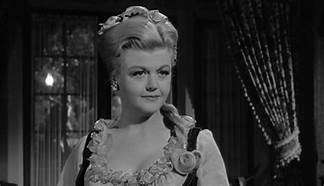
James Gregory portrays "Senator John Yerkes Iselin". A possible candidate for the Vice Presidency of the United States. The character is modeled after Senator Joseph McCarthy.
.
Those four people are the characters the story revolves around. The feature co-stars Janet Lee as Sinatra's love interest "Eugenie Rose Chaney".
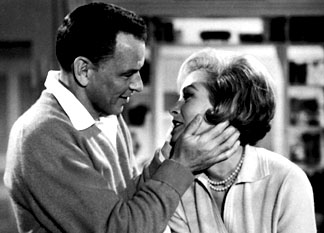
Henry Silva plays "Chunjin". The audience knows, from the opening five minutes, that he was the guide for the American soldiers who were captured. He is now, surprisingly, the "Houseboy" for Lansbury, Gregory, and Harvey. In reality he is a North Korean Army Officer.
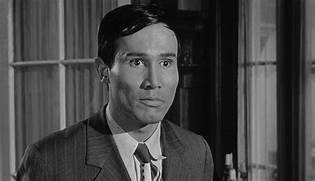
Khigh Dheigh plays the Communist Chinese "Dr. Yen Lo".

Before I go further into the plot. I would point out what had started eight days prior to this picture's release. This was the exact date of my 16th Birthday, October 16, 1962. The United States and the Soviet Union were actually on the brink of Nuclear War from what became known as "The Cuban Missile Crisis".
Tensions were very high and into that unstable climate came John Frankenheimer's "The Manchurian Candidate". Unexpectedly arriving at the height of "Cold War" tensions in the United States and making the movie more troubling for many.
Returning to the plot:
"Major Marco's" has been having dreams, nightmares more likely, and he seems to be attempting to remember something, but what?
One thing that "Marco" is noticing is that he has a strong friendship with "Raymond Shaw", but this seems false in some way. Ask "Marco" what he thinks of "Raymond" and immediately, every time, he repeats:
Some of the Major's nightmares show the platoon on a stage with a Chinese Doctor explaining a theory to his audience. Then the "Doctor" asks "Raymond" to take a pistol and shoot one of the other members of his captured platoon. "Shaw" complies as the other soldiers and his intended victim just ignore everything he is doing as if this is normal. Two killings will happen in "Major Marco's" nightmarish dreams. The two men he dreamed of "Raymond Shaw" shooting are also the two missing in action.
Sometimes the nightmare's setting changes, but the actions remain the same.
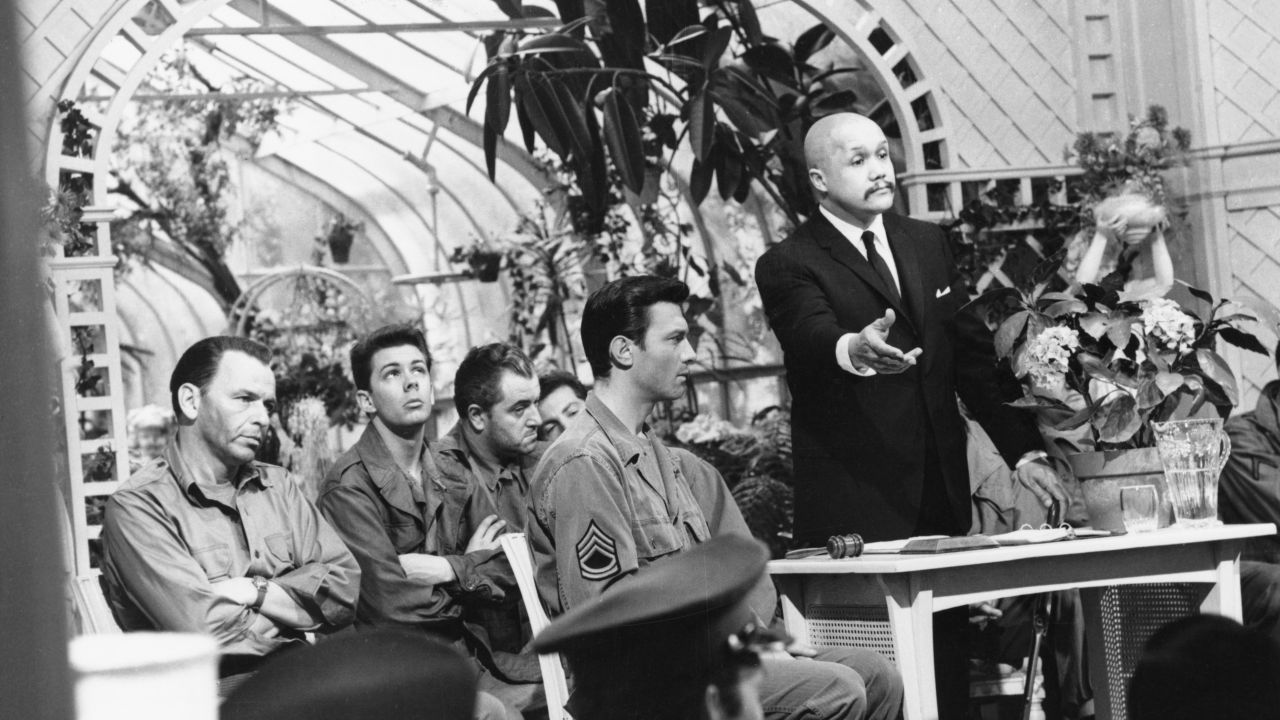
In one dream the Chinese Doctor starts out as women addressing a gathering of other women interested in horticulture.

In another nightmare all the participants in the audience become African-American women. As does the Chinese Doctor addressing them.

"Major Marco" decides to go to Army Intelligence with his concerns. Which seem to point to his platoon having been "Brain Washed", but for what objective? Also he questions why his platoon suddenly likes "Raymond Shaw"? Whom "Marco" now remembers was extremely disliked?

Things start to fall into place. When "Raymond's" Step-father, "Senator Iselin", becomes Joseph McCarthy in form. He is driven by his seemingly ambitious wife to start claiming that the Department of Defense is full of Communist agents. Her domineering personality gets her husband to campaign for the Vice President spot on his unnamed political party's ticket.
The audience confirms that "Raymond Shaw" has been "Brain Washed" by the Chinese Communist Doctor. He must obey any command given to him after seeing the playing card the "Queen of Diamonds". Other than the houseboy "Chunjin" is there someone else?
At a costume party, given by his mother, to obtain support for his Step-father's run for the Vice Presidential nomination. "Raymond Shaw's" old girlfriend "Jocelyn Jordon", Leslie Parrish, shows up wearing a "Queen of Diamonds" costume. This accidental costume sets off "Raymond" in an unexpected way. "Jocelyn" reminds him of his pre-wartime promise of marriage. Under the influence of the costume the two elope. One problem for the two is that "Jocelyn Jordon's" father is "Senator Thomas Jordon" a political foe of "Iselin's".
This unforeseen elopement will lead to revealing that "Raymond's" mother is a Communist agent and his controller. To help her husband she has her son murder "Senator Jordon" in his home. "Jocelyn" walks in and is murdered also..Afterwards, "Raymond" has no knowledge of what he did and is grief stricken over the murders by persons unknown..
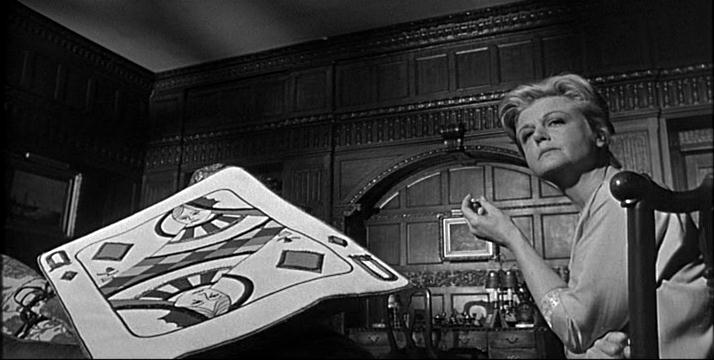
Meanwhile, "Major Marco" goes to "Shaw's" apartment and recognizes the Houseboy as "Chunjin". While attempting to find out what the North Korean is doing there. A fight starts between the two men, but the.other house staff stop the fight and "Marco" leaves with more questions than answers.
Army Intelligence has figured out the probability of the "Queen of Hearts" triggering "Raymond Shaw". They believe that whomever is controlling him is planning to get "Iselin" the Vice Presidential nomination. Adding that probably the Presidential candidate will be assassinated by "Shaw". Which would make "Senator John Yerkes Iselin" a Presidential candidate with the sympathy of the American people. The unknowing "Senator Iselin" would become the Chinese Communist's "MANCHURIAN CANDIDATE", being controlled by his wife.
"Marco" goes to "Shaw" with a deck of cards with nothing but "Queen of Diamonds" in an attempt to clear his "Brain Washing".
The climax comes at the unnamed Party's convention in Madison Square Garden in New York City. The clear headed, maybe, "Raymond Shaw" takes the sniper rifle his mother had left for him and goes into a room with a view of the stage. "Marco" attempts to stop him, but is himself stopped by "Raymond", being knocked out and left in a corridor before the room.

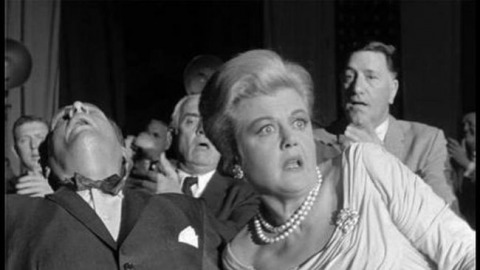
In the locked room "Shaw" views the stage and sees his mother and step-father, now, the Vice Presidential candidate as planned. "Raymond's" first shot takes out "Senator Iselin" and the second his mother. "Major Marco" breaks in just as "Raymond Shaw" wearing his Congressional Medal of Honor kills himself.
As I said the timing of the release of "The Manchurian Candidate" couldn't have been more perfect, if it had been planned. The subject matter had always been in the recesses of most American adults minds since the start of the "Cold War". President Kennedy had been escalating the involvement of the United States, slowly, in a country. at first, most American's didn't know existed called Vietnam and of course there were those events, I mentioned, that started on my birthday. One of America's nightmare had reached the screen in a tightly made politically thriller. Could it ever actually happen?

In 2004 a revised and updated remake of "The Manchurian Candidate" was made by Jonathan Demme. It starred Denzel Washington, Liev Schreiber and Meryl Streep and dealt with brainwashed Desert Storm soldiers.
If the idea of an American President CONTROLLED by a Communist Power was unnerving to American's in 1962. Director John Frankenheimer followed that idea with a Military take over of the United States government.
SEVEN DAYS IN MAY released February 12, 1964
The same year Frankenheimer's previous political thriller came out. The authors Fletcher Knebel and Charles H. Bailey II published their novel "Seven Days in May".
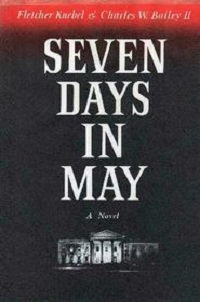
According to Knebel he got his idea for the story after interviewing Air Force Chief of Staff Curtis Lemay. It is believed that Knebel and Bailey used Army General Edwin A, Walker as the model for Air Force General "James 'Gentleman Jim' Matton Scott".
Who was General Edwin A. Walker?

General Walker served in both World War 2 and the Korean War. He was a staunch Conservative Republican and was criticized by President Dwight David Eisenhower for expressing his political views while wearing his Army Uniform.
Walker resigned his commission in 1959, but President Eisenhower refused to accept in and instead assigned him to Command the 24th Infantry Division in Ausberg, Germany. Walker again resigned his commission in 1961 after being publicly admonished by the Joint Chiefs of Staff for calling both Eleanor Roosevelt and President Harry Truman "Pink" in print and violating the "Hatch Act".
For those of my readers unfamiliar with the source of the word "Pink" in this instance. In 1950 while running for the U.S. Senate in California against Democratic candidate actress Helen Gahagan Douglas. Richard Nixon knew that referring to her as a "Communist", or using the term "Red", in popular use for decades, might back fire on him. So he referred to Gahahan Douglas as wearing "Pink" underwear and the voters knew would he implied. In 1925 the word "Pinko" was first used. This referred to somebody with either extreme left wing leanings, or a communist sympathizer.
The 1939 "Hatch Act", actually "An Act to Prevent Pernicious Activities", was designed to prevent employees of the Executive Branch of the Government except the President, Vice President and certain designated high-level-officials from participating in some form of political activity. In the 1950 incident, General Edwin A. Walker, was telling his troops who to vote for in the upcoming elections.
President Kennedy accepted Walker's second resignation letter over other actions he had taken. Thus making him the only General to resign his commission during the 20th Century. Edwin Walker ran for Governor of Texas and lost to John Connally in 1962.
The following two entries are from a New York Times article dated September 30, 1962 concerning the desegregation of Mississippi schools..
On April 10, 1963 Edwin A. Walker was the target of an assassination attempt. After the "Warren Commission" finished their investigation into the assassination of President Kennedy. Within the Commission's report was their conclusion that the attempt of Walker's life had been by Lee Harvey Oswald.

This then was the man Fletcher Knebel and Charles H. Baily II turned into their head of the "Joint Chief of Staffs" for "Seven Days in May". When the novel came out President John F. Kennedy read it and was quoted as saying he believed such a military take over was very possible.
Turning the novel into a screenplay was given to Rod Sterling. The novel was set in May of 1974 and the implication is that is still the year of the movie. The novel takes place after a stalemated war in Iran. This is changed to the signing of a nuclear disarmament treaty with the Soviet Union in Sterling's screenplay. Making the Nation's Cold War fears, in 1964, a more ominous feature than a war with Iran.
The motion picture was released, as I mentioned, on February 12, 1964. What was actually going on for American's at that time? Here are some highlights between the start of the year and the date of the release of "Seven Days in May":
January 5th Barry Goldwater announced he will seek the Republican nomination for President.
January 7th in his first State of the Union. President Johnson declares the war on poverty.
January 12th the first U.S. Navy patrols of the South China Sea begins.
January 18th plans to build the World Trade Center are announced.
January 27th China and France announce diplomatic relations and U,S, Senator Margaret Chase Smith announces she will run for the Republican Presidential nomination.
January 28th a U.S. Air Force jet strays into East Germany and is shot down by Soviet fighters. The three man crew is killed.
January 30th the Vietnam War becomes front and center as General Nguyen Khanh leads a bloodless military coup d'etat to become President of South Vietnam.
February 3rd Black and Puerto Rican students protest racial segregation in New York City.
February 6th Cuba cuts off the normal water supply to the Guantanamo Navy Base.
February 7th a Jackson Mississippi jury trying Bryon De La Beckwith for the murder of Megar Evers in June 1963. Reports they can not reach a verdict and a mistrial is declared.
February 11th the Republic of China (Taiwan) severs diplomatic relations with France over their new agreement with Mainland China.
February 12th at the start of the ninth year of the Vietnam War this feature is released.
Portraying the central character "Air Force General James 'Gentleman Jim' Mattoon Scott".was Burt Lancaster.

Portraying his aide "USMC Colonel 'Jiggs' Casey was Kirk Douglas. This film, although he did not produce it, was Douglas's baby. He got Producer Edward Lewis and Director John Frankenheimer to make the motion picture and his friend Burt Lancaster to portray "Matoon Scott".
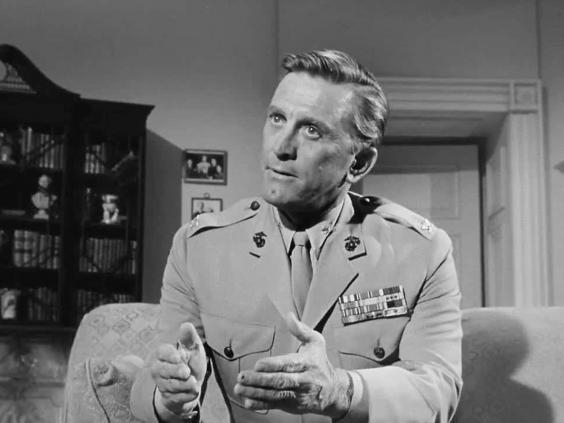
Portraying "President Jordon Lyman" was Fredrick March. Although the film takes place in the 1970's. There was no question that March was the current President Lyndon Baines Johnson. Lyman, in Rod Sterling's script, remarks that "General Walker" was one of those "False Profits". Who were offering themselves to the American People as a leader.

Ava Gardner was "Eleanor Holbrook".
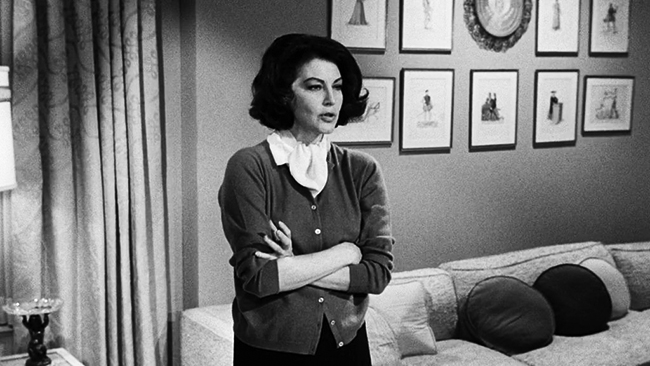
Edmond O'Brien portrayed "Senator Ray Clark". O'Brien received an Oscar nomination for Best Supporting Actor for this role.
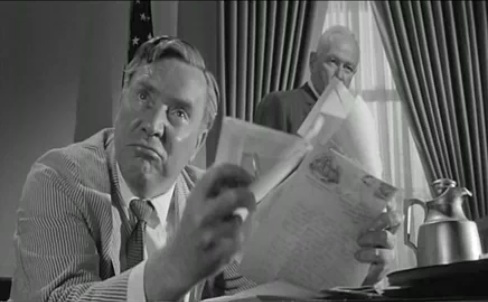
Martin Balsam portrayed the aide to the President "Paul Girard".

The motion picture opens, as I mentioned, just after "President Lyman" has signed a very unpopular nuclear disarmament treaty with the Soviet Union. To put the story once more in prospective.
In actuality on August 5, 1963, the Soviet Union, the U.K. and the United States signed "The Partial Nuclear Test Ban Treat (PNT)". Which, if my reader were to get a copy is really called the "Treaty Banning Nuclear Weapon Tests in the Atmosphere, in Outer Space and Under Water". In short the parties could only test underground. This did not ease the minds of American's about a Soviet build up of nuclear weapons, or the possibility of a nuclear war.
Five years later and four after this motion picture. On July 1, 1968. 18 members of the United Nations including the Soviet Union and the United States signed the "Treaty on the Non-Proliferation of Nuclear Weapons (NPT)". Which didn't go into effect until March 5, 1970. The main concept of this treaty was:
Speaking of substitution, as I write this article, in the United States my reader could change the Soviet Union into North Korea. With their nuclear program and the testing of missiles that potentially could reach Japan, Hawaii, Guam and even the West Coast of the United States.
Returning to John Frankenheimer's motion picture. Demonstrations have broken out across the country and especially around the White House over the disarmament treaty. As with many issues some demonstrators are pro and others con.
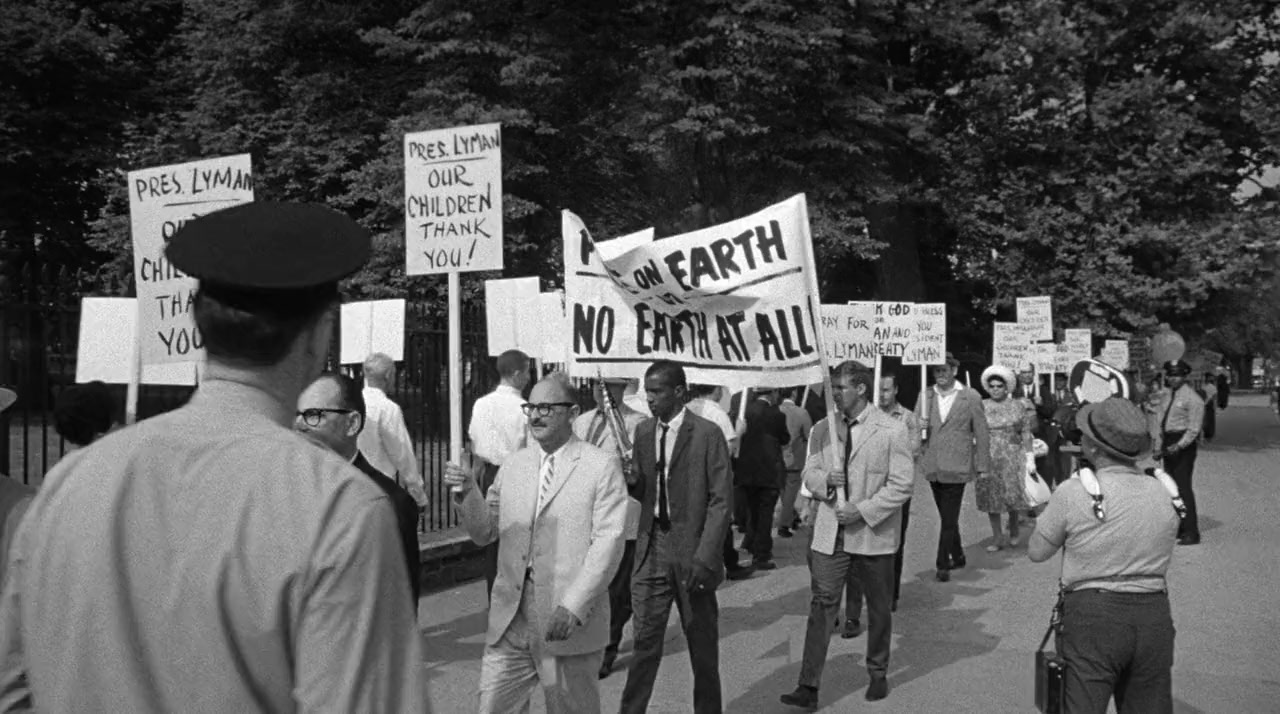
The treaty, although ratified by the United States Senate, has the President's opposition in full force. The military, while seemingly going along with it, look upon the disarmament treaty as kowtowing to the Soviet Union. Whom they distrust and consider our number one enemy.
By accident "USMC Colonel 'Jiggs' Casey", the Director of the Joint Chief's staff, stumbles upon what appears to be a coup d'etat in progress to remove both the President and his Cabinet by the Joint Chiefs. This is to happen at the end of the next Seven Days and the information was given to "Casey" by another officer presuming he's was part of it.
Is it true? It definitely seems unbelievable, but how to prove it one way or another?
Under the plan a Top Secret Army Unit known as "ECOMCON (Emergency COMmunications CONtrol)"will seize control of the country's phone system. Along with both radio and television networks. While Congress is physically prevented from implementing the treaty.
"Colonel Casey" doesn't like a lot of "President Lyman's" policies including the nuclear disarmament treaty, but he took an Oath to defend the Constitution and the Country against all enemies Foreign and Domestic. . He believes, if true, the actions of the Joint Chiefs are against that Oath.
"Jiggs" goes to "President Jordon Lyman" with his suspicions.
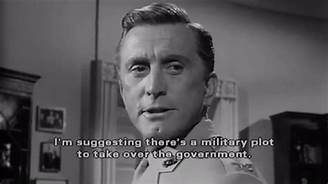
"Lyman" calls a meeting of those he feels he can trust to bring them into what "Colonel Casey" may have uncovered.
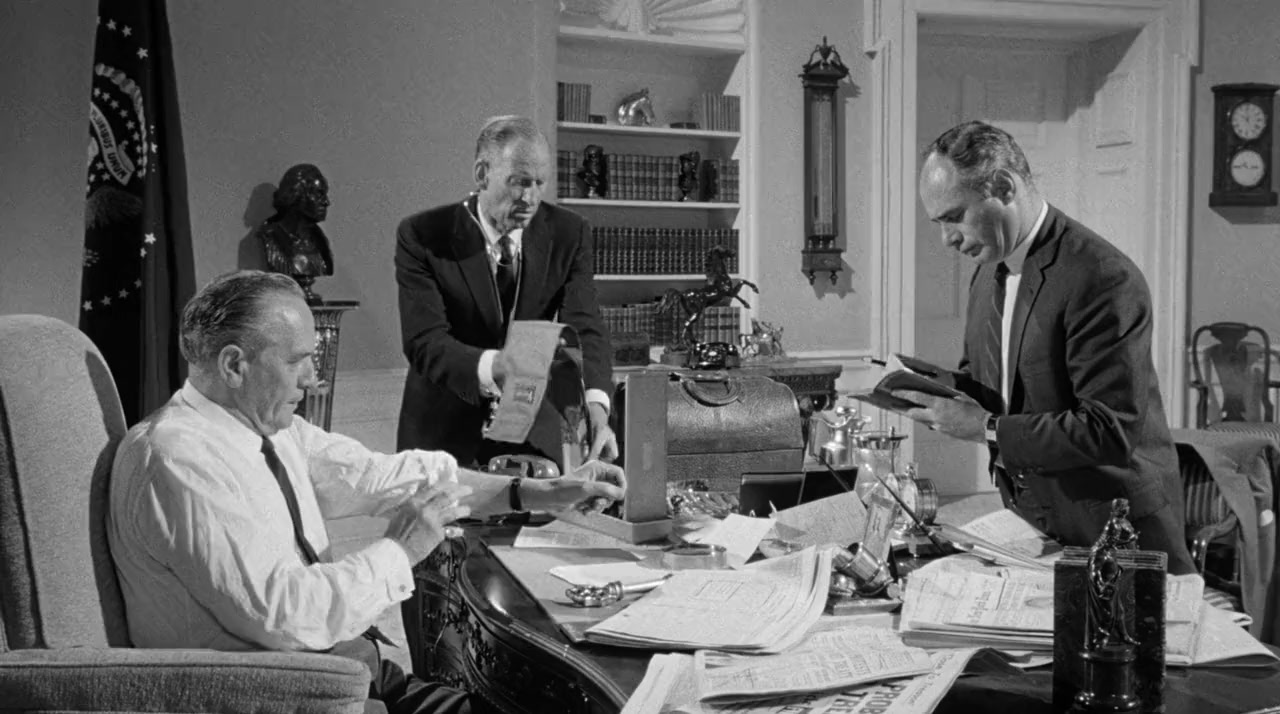
"Casey" goes to "General Mattoon Scott's" ex-mistress, "Eleanor Holbrook", to see what information he can get to use against him. Such as indiscreet letters "Casey" is aware he wrote.

The alcoholic "Senator Clarke" is sent to Fort Bliss, near El Paso, Texas to locate a secret staging base for the coup and the President's aide, :"Paul Girard" is sent to the Mediterranean to get a confession from "Vice Admiral Barnswell", John Houseman, who refused to be part of the military plot to overthrow the government. He gets the confession, but on his way back to Washington, D.C., his plane crashes. Meanwhile, "Senator Clarke" is taken prisoner by loyalists to "Mattoon Scott".However, the real base commander, not part of the plot, and friend of "Jiggs", "Colonel William 'Mutt'Henderson", Andrew Duggan, helps him escape. The two reach Washington, D.C., but when separated from "Senator Clarke", for a few minutes, "Colonel Henderson" is abducted.
"President Lyman" calls the Head of the Joint Chiefs "Air Force General James 'Gentleman Jim' Mattoon Scott" to the Oval Office. "Lyman" reveals his knowledge of the plot and demands that "Mattoon Scott" and the other plotters resign, He is refused, because the General feels he has the upper hand and the President does not use the letters obtained from "Eleanor Holbrook" to force the other's hand.

"Matoon Scott" tells the other Joint Chiefs to stay in the plot as the President has no concrete proof. He goes on television to address the nation, believing the American people are behind him.
"President Jordon Lyman" holds a Press Conference to counter "Mattoon-Scott" demanding the resignation of all members of the plotters to overthrow the United States Government. As he is speaking a man approaches and hands the President "Vice Admiral Barnswell's" confession found in the wreckage of "Paul Girard's" plane.
Afterwards copies of the confession are handed to each plotter and they all resign in disgrace. The President again addresses the country with a speech about the future.
The following is the cover of Fletcher Knebel's follow up novel to "Seven Days in May". It was picked up for a possible motion picture, but not made. It was felt the premise too extreme and might reflect too negatively on the office of the American Presidency. I leave my reader with the novel's tag line and deciding, if they believe, one way or another, that the premise is too extreme.

I've mentioned how the fear of nuclear war with the Soviet Union affected even an elementary student like myself in the 1950's.
During those years and into the 1960's the motion picture industry across the globe had been creating Science Fiction pictures of what the world would be like AFTER a nuclear strike. In 1951 "Five" was the first such motion picture and was from United States' playwright, novelist, screenplay and radio writer Arch Obler. In 1956 I watched Roger Corman's cult classic "The Day the World Ended", in 1959 Stanley Kramer turned British author Nevil Shute's "On the Beach" into a feature film. While in 1961 Japan made "The Great War" and from the U.K. that same year was the classic "The Day the Earth Caught Fire". Actor and Director Ray Milland made a very good low budget 1962 motion picture about a typical American family experiencing "Panic in the Year Zero". After Los Angeles and other West Coast cities were destroyed by nuclear weapons.
In 1958 Welsh author Peter Bryan George writing as Peter Bryant published a novel "Two Hours to Doom". In the United States the novel would be entitled "Red Alert". His story was not about a nuclear accident, but a madman in a position of authority using nuclear weapons to start World War 3.
Four years after the publication of Peter Bryant's novel in the United Kingdom. Authors Eugene Burdick and Harvey Wheeler wrote another novel, "Fail Safe", in the United States, but this was about technology causing a nuclear incident.
Before I speak too the motion pictures. I bring up the name John von Neumann.
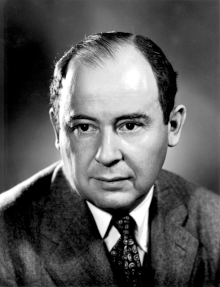
Von Neumann was a Hungarian-American mathematician, physicist, computer scientist and polymath. During World War 2 he worked on the "Manhattan Project".and after the war he served of the advisory committee for the "United States Atomic Energy Commission".
John von Neumann developed the theory of "Mutual assured destruction (MAD)". "MAD" is a doctrine of military strategy and national security. Which basically states that the use of nuclear weapons by any two, or more opponents would result in the complete annihilation of both the attacker and defender. The authors of both novels used his theory as the basis for their work.
A variation of the nuclear arms race between the Soviet Union and the United States developed into a race to get which novel, "Two Hours to Doom", or "Fail Safe" to the motion picture screen first.
DR. STRANGELOVE OR: HOW I LEARNED TO STOP WORRYING AND LOVE THE BOMB released January 29, 1964.

Stanley Kubrick and co-screenplay writers Terry Southern and Peter George turned George's novel into a "Black Comedy" aka: "Dark Comedy" aka: "Gallows Humor" story. Which to start with was reflected in the names of the main characters/
Stanley Hayden was paranoid over "Body Fluids" "Air Force General Jack D. Ripper" and if the audience didn't get the pun in his name. They were already too far off base to enjoy the motion picture.

The comedy genius that was Peter Sellers had three roles.
The first was as "RAF Group Captain Lionel Mandrake". An exchange officer under the command of "Ripper".

The second was the "President of the United States Merken Muffley".
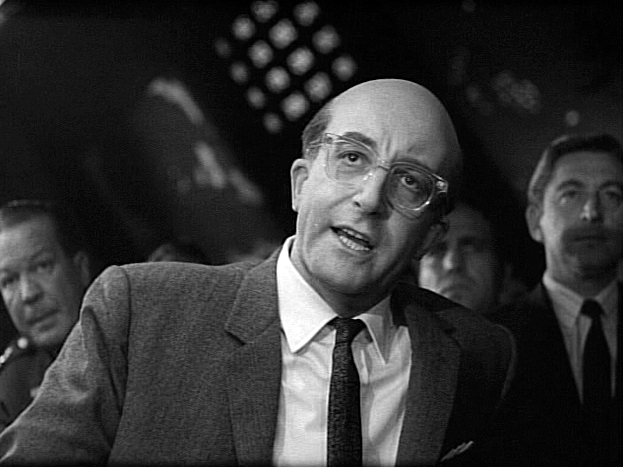
The third, the title character, America's number one nuclear war expert/ Who just happens to be an ex-Nazi "Dr. Strangelove".

George C. Scott was the United States Air Force Chief of Staff/
"General Buck Turgidson".

Portraying the bomber pilot "Major T.J. "King" Kong" was Slim Pickens
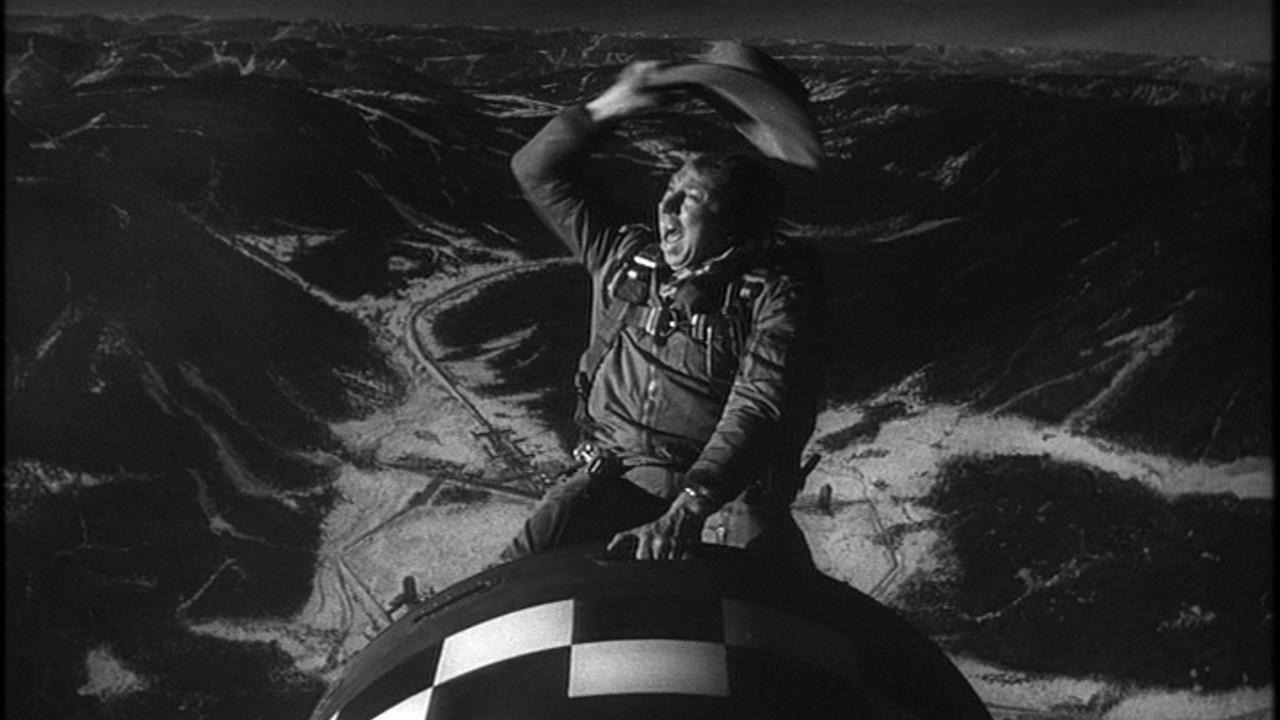
Keenan Wynn was "Army Colonel Bat Guano".

"General Jack D. Ripper" is in command of Burpelson Air Force Base. The home of the Strategic Air Command's 843rd Bomber Group of B-52's. They are on a routine patrol flight towards Soviet Air Space and are now two hours out from their targets in Russia. Each plane carries hydrogen bombs.
"Ripper" calls his executive officer "Group Captain Mandrake" and orders the base to be put on full alert and lock down. He next issues "Wing Attack Plan R" putting the aircraft on war footing and ordered to proceed to their designated targets, not to answer any radio communication other than from Burpelson and to drop their payloads over those targets. Only a three letter code known to "Ripper" will get them to answer.
Below "Jack D. Ripper" tells "Captain Mandrake" there is a Communist plot "to pollute America's precious bodily fluids" during "the physical act of love". He blames it on the fluoridation of America;s water supply. "Mandrake" is convinced "Ripper's" insane, but what to do?

The idea of a Communist plot to pollute body fluids may seem laughable today, but back in 1964 it wasn't and that conspiracy theory first started in the 1950's. Below is an actual illustration from 1955 by the "Keep America Committee". Many fundamentalist Christian religions still believe in the "Unholy Three" and, today, believe that Flu Vaccines cause Autism.

Mental Hygiene was a plot to subvert our minds. Polio vaccines were made from monkeys, think "The Scopes Trial" and Evolution, and Fluoridated water poisoned Americans. So a Communist plot to attack American's during sex was right up there with this alternative reality.
Word has been received by the Joint Chiefs from "General Ripper". In the Pentagon War Room "General Buck Turgidson" briefs "President Muffley", his cabinet and other military officers. According to "Turgidson" every possible three letter code is being tried to contact the B-52's on their way to Russian Targets, but without success and it could take two days to find the correct one. Also "Plan R" was designed to allow any Senior Officer to launch a retaliatory strike, if all Senior Officers above them have been killed in a First Strike.
The President orders the United States Army to storm the base and capture the General. "General Turgidson" advises the President to just let the attack go through, but "Muffley" will have nothing to do with a First Nuclear Strike on even the Soviet Union.
Instead the President has the Soviet Ambassador "Alexei de Sadeski", Peter Bull, brought into the War Room to call the Soviet Prime Minister on the "Hot Line" We never see him, but his name is "Dimitri Kissov". Talking to "Kissov" he offers to reveal the positions of the planes so that the Soviets can defend themselves leading to a heated conversation.
The Soviet Ambassador reveals that they have created a "Doomsday Machine" and that it will be automatically triggered by a computer should Russia be attacked. The bombs are buried and are jacketed with "Cobalt-thorium G". The "Cobalt-thorium" will cause intense radiation. In two months time the Earth will be encircled with radiation wiping out all human and animal life for 93 years.
The President's wheel chair bound scientific adviser "Dr. Strangelove" points out to the Ambassador that such a "Doomsday Machine" would not be effective unless everyone knew about. "De Sadeski" says "Kissov" was to have revealed it next week.

The Army arrives at Burpelson and a firefight between the U.S. Army and U.S. Air Force begins. Knowing the outcome "General Jack D. Ripper" commits suicide. "Captain Mandrake" finds the three letter code "OPE" and relays the code to the Pentagon.
All the planes but the one commanded by "King Kong" are recalled. Earlier a Soviet missile damaged both the fuel tanks and the radio equipment. Contact can not be made. "President Muffley" reveals to the Soviets the B-52's target, but because of the damage "Kong" changes targets.
The bomb bay doors won't open. "Major Kong" enters the bomb bay and repairs the wiring. The doors open and he rides the H-Bomb down.
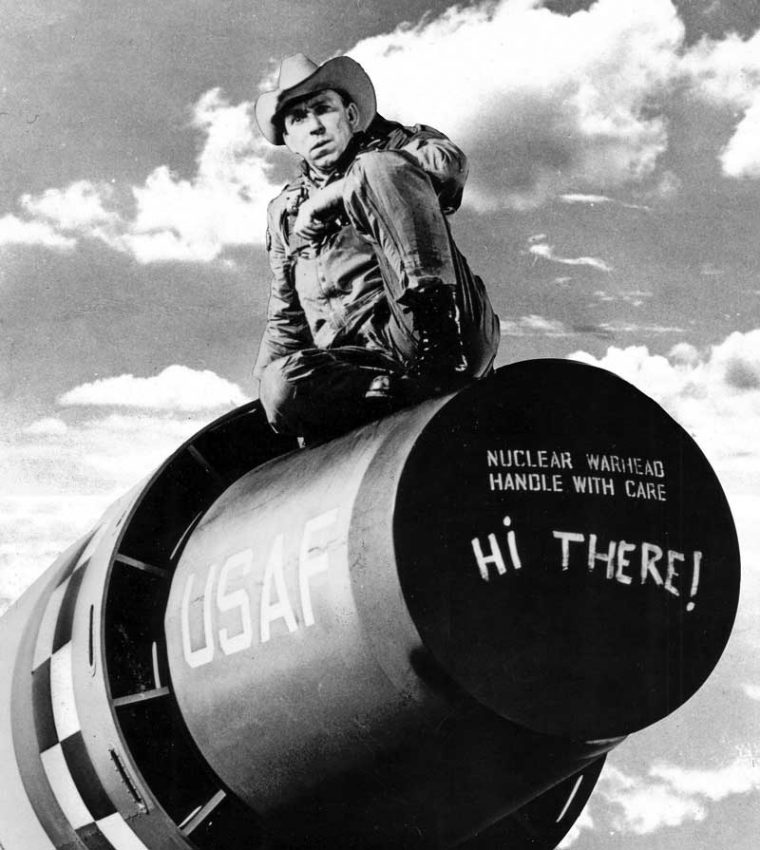
In the war room "Dr. Strangelove" suggests that "President Muffley" gather several hundred thousand people and have them go deep into mine shafts. He further suggests a 10 to 1 Female to Male make up for a solid breeding program to repopulate the Earth. "General Turgidson" states the Soviets will do the same. At which point "Dr. Strangelove" rises out of his chair and says he can walk again.
The "Doomsday Machine" kicks in and Stanley Kubrick ends his feature film with a montage of multiple atomic bombs exploding as the World War 2 song "We Will Meet Again" plays.
We'll meet again
We'll meet again
Don't know where
Don't know when
But I know we'll meet again some sunny day
Keep smiling through
Just like you always do
Till the blue skies drive the dark clouds far away
So will you please say "Hello"
To the folks that I know
Tell them I won't be long
They'll be happy to know
That as you saw me go
I was singing this song
Audiences may have laughed at nuclear war in "Dr. Strangelove: Or How I Stopped Worrying and Learned to Love the Bomb", but ten months later in October that fear became very realistic on the motion picture screen.
FAIL SAFE released October 7, 1964.
One interesting aspect to the movie's screenplay written by Walter Bernstein was that Peter George, without on screen credit,.also worked on rewrites. As both pictures were released by Columbia Pictures.
Co-Producer and Director Sidney Lument wanted the picture to be as realistic as possible.
To increase the tension of the screenplay. The movie was filmed in stark black and white and Lument chose to use what was described as a dramatic theatrical style. He used extreme close-ups for a very on screen claustrophobic effect. Sidney Lument utilized shadows, which only could be created in black and white, and very long periods of total silence between the characters lines. Music, normally used to accent scenes in motion pictures,was almost non-existent except if a radio was on.
Continuing his approach with the exception of a few minor scenes. All the action takes place either in the White House underground bunker, the Pentagon and SAC war rooms and the cockpit of a single "Vindicator" bomber.
The unnamed President of the United States was portrayed by Henry Fonda.

Portraying "Raymond's" mother was Angela Lansbury. The widow "Mrs. Shaw" had remarried "Senator Iselin" prior to her son joining the Army.
James Gregory portrays "Senator John Yerkes Iselin". A possible candidate for the Vice Presidency of the United States. The character is modeled after Senator Joseph McCarthy.
.
Those four people are the characters the story revolves around. The feature co-stars Janet Lee as Sinatra's love interest "Eugenie Rose Chaney".

Henry Silva plays "Chunjin". The audience knows, from the opening five minutes, that he was the guide for the American soldiers who were captured. He is now, surprisingly, the "Houseboy" for Lansbury, Gregory, and Harvey. In reality he is a North Korean Army Officer.
Khigh Dheigh plays the Communist Chinese "Dr. Yen Lo".
Before I go further into the plot. I would point out what had started eight days prior to this picture's release. This was the exact date of my 16th Birthday, October 16, 1962. The United States and the Soviet Union were actually on the brink of Nuclear War from what became known as "The Cuban Missile Crisis".
Tensions were very high and into that unstable climate came John Frankenheimer's "The Manchurian Candidate". Unexpectedly arriving at the height of "Cold War" tensions in the United States and making the movie more troubling for many.
Returning to the plot:
"Major Marco's" has been having dreams, nightmares more likely, and he seems to be attempting to remember something, but what?
One thing that "Marco" is noticing is that he has a strong friendship with "Raymond Shaw", but this seems false in some way. Ask "Marco" what he thinks of "Raymond" and immediately, every time, he repeats:
Raymond Shaw is the kindest, bravest, warmest, most wonderful human being I've ever known in my life."Marco" begins to speak to members of his platoon. He discovers that every other member when asked what they think of Shaw. Repeats, word for word, the exact same answer he does.
Some of the Major's nightmares show the platoon on a stage with a Chinese Doctor explaining a theory to his audience. Then the "Doctor" asks "Raymond" to take a pistol and shoot one of the other members of his captured platoon. "Shaw" complies as the other soldiers and his intended victim just ignore everything he is doing as if this is normal. Two killings will happen in "Major Marco's" nightmarish dreams. The two men he dreamed of "Raymond Shaw" shooting are also the two missing in action.
Sometimes the nightmare's setting changes, but the actions remain the same.

In one dream the Chinese Doctor starts out as women addressing a gathering of other women interested in horticulture.

In another nightmare all the participants in the audience become African-American women. As does the Chinese Doctor addressing them.

"Major Marco" decides to go to Army Intelligence with his concerns. Which seem to point to his platoon having been "Brain Washed", but for what objective? Also he questions why his platoon suddenly likes "Raymond Shaw"? Whom "Marco" now remembers was extremely disliked?

Things start to fall into place. When "Raymond's" Step-father, "Senator Iselin", becomes Joseph McCarthy in form. He is driven by his seemingly ambitious wife to start claiming that the Department of Defense is full of Communist agents. Her domineering personality gets her husband to campaign for the Vice President spot on his unnamed political party's ticket.
The audience confirms that "Raymond Shaw" has been "Brain Washed" by the Chinese Communist Doctor. He must obey any command given to him after seeing the playing card the "Queen of Diamonds". Other than the houseboy "Chunjin" is there someone else?
At a costume party, given by his mother, to obtain support for his Step-father's run for the Vice Presidential nomination. "Raymond Shaw's" old girlfriend "Jocelyn Jordon", Leslie Parrish, shows up wearing a "Queen of Diamonds" costume. This accidental costume sets off "Raymond" in an unexpected way. "Jocelyn" reminds him of his pre-wartime promise of marriage. Under the influence of the costume the two elope. One problem for the two is that "Jocelyn Jordon's" father is "Senator Thomas Jordon" a political foe of "Iselin's".
This unforeseen elopement will lead to revealing that "Raymond's" mother is a Communist agent and his controller. To help her husband she has her son murder "Senator Jordon" in his home. "Jocelyn" walks in and is murdered also..Afterwards, "Raymond" has no knowledge of what he did and is grief stricken over the murders by persons unknown..

Meanwhile, "Major Marco" goes to "Shaw's" apartment and recognizes the Houseboy as "Chunjin". While attempting to find out what the North Korean is doing there. A fight starts between the two men, but the.other house staff stop the fight and "Marco" leaves with more questions than answers.
Army Intelligence has figured out the probability of the "Queen of Hearts" triggering "Raymond Shaw". They believe that whomever is controlling him is planning to get "Iselin" the Vice Presidential nomination. Adding that probably the Presidential candidate will be assassinated by "Shaw". Which would make "Senator John Yerkes Iselin" a Presidential candidate with the sympathy of the American people. The unknowing "Senator Iselin" would become the Chinese Communist's "MANCHURIAN CANDIDATE", being controlled by his wife.
"Marco" goes to "Shaw" with a deck of cards with nothing but "Queen of Diamonds" in an attempt to clear his "Brain Washing".
The climax comes at the unnamed Party's convention in Madison Square Garden in New York City. The clear headed, maybe, "Raymond Shaw" takes the sniper rifle his mother had left for him and goes into a room with a view of the stage. "Marco" attempts to stop him, but is himself stopped by "Raymond", being knocked out and left in a corridor before the room.


In the locked room "Shaw" views the stage and sees his mother and step-father, now, the Vice Presidential candidate as planned. "Raymond's" first shot takes out "Senator Iselin" and the second his mother. "Major Marco" breaks in just as "Raymond Shaw" wearing his Congressional Medal of Honor kills himself.
As I said the timing of the release of "The Manchurian Candidate" couldn't have been more perfect, if it had been planned. The subject matter had always been in the recesses of most American adults minds since the start of the "Cold War". President Kennedy had been escalating the involvement of the United States, slowly, in a country. at first, most American's didn't know existed called Vietnam and of course there were those events, I mentioned, that started on my birthday. One of America's nightmare had reached the screen in a tightly made politically thriller. Could it ever actually happen?

In 2004 a revised and updated remake of "The Manchurian Candidate" was made by Jonathan Demme. It starred Denzel Washington, Liev Schreiber and Meryl Streep and dealt with brainwashed Desert Storm soldiers.
If the idea of an American President CONTROLLED by a Communist Power was unnerving to American's in 1962. Director John Frankenheimer followed that idea with a Military take over of the United States government.
SEVEN DAYS IN MAY released February 12, 1964
The same year Frankenheimer's previous political thriller came out. The authors Fletcher Knebel and Charles H. Bailey II published their novel "Seven Days in May".

According to Knebel he got his idea for the story after interviewing Air Force Chief of Staff Curtis Lemay. It is believed that Knebel and Bailey used Army General Edwin A, Walker as the model for Air Force General "James 'Gentleman Jim' Matton Scott".
Who was General Edwin A. Walker?

General Walker served in both World War 2 and the Korean War. He was a staunch Conservative Republican and was criticized by President Dwight David Eisenhower for expressing his political views while wearing his Army Uniform.
Walker resigned his commission in 1959, but President Eisenhower refused to accept in and instead assigned him to Command the 24th Infantry Division in Ausberg, Germany. Walker again resigned his commission in 1961 after being publicly admonished by the Joint Chiefs of Staff for calling both Eleanor Roosevelt and President Harry Truman "Pink" in print and violating the "Hatch Act".
For those of my readers unfamiliar with the source of the word "Pink" in this instance. In 1950 while running for the U.S. Senate in California against Democratic candidate actress Helen Gahagan Douglas. Richard Nixon knew that referring to her as a "Communist", or using the term "Red", in popular use for decades, might back fire on him. So he referred to Gahahan Douglas as wearing "Pink" underwear and the voters knew would he implied. In 1925 the word "Pinko" was first used. This referred to somebody with either extreme left wing leanings, or a communist sympathizer.
The 1939 "Hatch Act", actually "An Act to Prevent Pernicious Activities", was designed to prevent employees of the Executive Branch of the Government except the President, Vice President and certain designated high-level-officials from participating in some form of political activity. In the 1950 incident, General Edwin A. Walker, was telling his troops who to vote for in the upcoming elections.
President Kennedy accepted Walker's second resignation letter over other actions he had taken. Thus making him the only General to resign his commission during the 20th Century. Edwin Walker ran for Governor of Texas and lost to John Connally in 1962.
The following two entries are from a New York Times article dated September 30, 1962 concerning the desegregation of Mississippi schools..
On September 26, 1962, Walker broadcast this message by several radio stations:
On September 29, 1962, he issued a televised statement:
In October 1962, while the nation was on the brink of nuclear war, Walker was arrested on the campus of the University of Mississippi for promoting race riots over the admission of African-American students.On April 10, 1963 Edwin A. Walker was the target of an assassination attempt. After the "Warren Commission" finished their investigation into the assassination of President Kennedy. Within the Commission's report was their conclusion that the attempt of Walker's life had been by Lee Harvey Oswald.

This then was the man Fletcher Knebel and Charles H. Baily II turned into their head of the "Joint Chief of Staffs" for "Seven Days in May". When the novel came out President John F. Kennedy read it and was quoted as saying he believed such a military take over was very possible.
Turning the novel into a screenplay was given to Rod Sterling. The novel was set in May of 1974 and the implication is that is still the year of the movie. The novel takes place after a stalemated war in Iran. This is changed to the signing of a nuclear disarmament treaty with the Soviet Union in Sterling's screenplay. Making the Nation's Cold War fears, in 1964, a more ominous feature than a war with Iran.
The motion picture was released, as I mentioned, on February 12, 1964. What was actually going on for American's at that time? Here are some highlights between the start of the year and the date of the release of "Seven Days in May":
January 5th Barry Goldwater announced he will seek the Republican nomination for President.
January 7th in his first State of the Union. President Johnson declares the war on poverty.
January 12th the first U.S. Navy patrols of the South China Sea begins.
January 18th plans to build the World Trade Center are announced.
January 27th China and France announce diplomatic relations and U,S, Senator Margaret Chase Smith announces she will run for the Republican Presidential nomination.
January 28th a U.S. Air Force jet strays into East Germany and is shot down by Soviet fighters. The three man crew is killed.
January 30th the Vietnam War becomes front and center as General Nguyen Khanh leads a bloodless military coup d'etat to become President of South Vietnam.
February 3rd Black and Puerto Rican students protest racial segregation in New York City.
February 6th Cuba cuts off the normal water supply to the Guantanamo Navy Base.
February 7th a Jackson Mississippi jury trying Bryon De La Beckwith for the murder of Megar Evers in June 1963. Reports they can not reach a verdict and a mistrial is declared.
February 11th the Republic of China (Taiwan) severs diplomatic relations with France over their new agreement with Mainland China.
February 12th at the start of the ninth year of the Vietnam War this feature is released.
Portraying the central character "Air Force General James 'Gentleman Jim' Mattoon Scott".was Burt Lancaster.

Portraying his aide "USMC Colonel 'Jiggs' Casey was Kirk Douglas. This film, although he did not produce it, was Douglas's baby. He got Producer Edward Lewis and Director John Frankenheimer to make the motion picture and his friend Burt Lancaster to portray "Matoon Scott".

Portraying "President Jordon Lyman" was Fredrick March. Although the film takes place in the 1970's. There was no question that March was the current President Lyndon Baines Johnson. Lyman, in Rod Sterling's script, remarks that "General Walker" was one of those "False Profits". Who were offering themselves to the American People as a leader.

Ava Gardner was "Eleanor Holbrook".

Edmond O'Brien portrayed "Senator Ray Clark". O'Brien received an Oscar nomination for Best Supporting Actor for this role.

Martin Balsam portrayed the aide to the President "Paul Girard".

The motion picture opens, as I mentioned, just after "President Lyman" has signed a very unpopular nuclear disarmament treaty with the Soviet Union. To put the story once more in prospective.
In actuality on August 5, 1963, the Soviet Union, the U.K. and the United States signed "The Partial Nuclear Test Ban Treat (PNT)". Which, if my reader were to get a copy is really called the "Treaty Banning Nuclear Weapon Tests in the Atmosphere, in Outer Space and Under Water". In short the parties could only test underground. This did not ease the minds of American's about a Soviet build up of nuclear weapons, or the possibility of a nuclear war.
Five years later and four after this motion picture. On July 1, 1968. 18 members of the United Nations including the Soviet Union and the United States signed the "Treaty on the Non-Proliferation of Nuclear Weapons (NPT)". Which didn't go into effect until March 5, 1970. The main concept of this treaty was:
the NPT non-nuclear-weapon states agree never to acquire nuclear weapons and the NPT nuclear-weapon states in exchange agree to share the benefits of peaceful nuclear technology and to pursue nuclear disarmament aimed at the ultimate elimination of their nuclear arsenals.This was the first treaty involving the United States and the Soviet Union that used the word "Disarmament". So the tension in the United States at the time of both the novel and feature film over a potential Nuclear War was extremely high and the reason a War in Iran from the novel was substituted for "President Lyman's" nuclear disarmament treaty.
Speaking of substitution, as I write this article, in the United States my reader could change the Soviet Union into North Korea. With their nuclear program and the testing of missiles that potentially could reach Japan, Hawaii, Guam and even the West Coast of the United States.
Returning to John Frankenheimer's motion picture. Demonstrations have broken out across the country and especially around the White House over the disarmament treaty. As with many issues some demonstrators are pro and others con.

The treaty, although ratified by the United States Senate, has the President's opposition in full force. The military, while seemingly going along with it, look upon the disarmament treaty as kowtowing to the Soviet Union. Whom they distrust and consider our number one enemy.
By accident "USMC Colonel 'Jiggs' Casey", the Director of the Joint Chief's staff, stumbles upon what appears to be a coup d'etat in progress to remove both the President and his Cabinet by the Joint Chiefs. This is to happen at the end of the next Seven Days and the information was given to "Casey" by another officer presuming he's was part of it.
Is it true? It definitely seems unbelievable, but how to prove it one way or another?
Under the plan a Top Secret Army Unit known as "ECOMCON (Emergency COMmunications CONtrol)"will seize control of the country's phone system. Along with both radio and television networks. While Congress is physically prevented from implementing the treaty.
"Colonel Casey" doesn't like a lot of "President Lyman's" policies including the nuclear disarmament treaty, but he took an Oath to defend the Constitution and the Country against all enemies Foreign and Domestic. . He believes, if true, the actions of the Joint Chiefs are against that Oath.
"Jiggs" goes to "President Jordon Lyman" with his suspicions.
"Lyman" calls a meeting of those he feels he can trust to bring them into what "Colonel Casey" may have uncovered.

"Casey" goes to "General Mattoon Scott's" ex-mistress, "Eleanor Holbrook", to see what information he can get to use against him. Such as indiscreet letters "Casey" is aware he wrote.

The alcoholic "Senator Clarke" is sent to Fort Bliss, near El Paso, Texas to locate a secret staging base for the coup and the President's aide, :"Paul Girard" is sent to the Mediterranean to get a confession from "Vice Admiral Barnswell", John Houseman, who refused to be part of the military plot to overthrow the government. He gets the confession, but on his way back to Washington, D.C., his plane crashes. Meanwhile, "Senator Clarke" is taken prisoner by loyalists to "Mattoon Scott".However, the real base commander, not part of the plot, and friend of "Jiggs", "Colonel William 'Mutt'Henderson", Andrew Duggan, helps him escape. The two reach Washington, D.C., but when separated from "Senator Clarke", for a few minutes, "Colonel Henderson" is abducted.
"President Lyman" calls the Head of the Joint Chiefs "Air Force General James 'Gentleman Jim' Mattoon Scott" to the Oval Office. "Lyman" reveals his knowledge of the plot and demands that "Mattoon Scott" and the other plotters resign, He is refused, because the General feels he has the upper hand and the President does not use the letters obtained from "Eleanor Holbrook" to force the other's hand.

"Matoon Scott" tells the other Joint Chiefs to stay in the plot as the President has no concrete proof. He goes on television to address the nation, believing the American people are behind him.
"President Jordon Lyman" holds a Press Conference to counter "Mattoon-Scott" demanding the resignation of all members of the plotters to overthrow the United States Government. As he is speaking a man approaches and hands the President "Vice Admiral Barnswell's" confession found in the wreckage of "Paul Girard's" plane.
Afterwards copies of the confession are handed to each plotter and they all resign in disgrace. The President again addresses the country with a speech about the future.
The following is the cover of Fletcher Knebel's follow up novel to "Seven Days in May". It was picked up for a possible motion picture, but not made. It was felt the premise too extreme and might reflect too negatively on the office of the American Presidency. I leave my reader with the novel's tag line and deciding, if they believe, one way or another, that the premise is too extreme.

I've mentioned how the fear of nuclear war with the Soviet Union affected even an elementary student like myself in the 1950's.
During those years and into the 1960's the motion picture industry across the globe had been creating Science Fiction pictures of what the world would be like AFTER a nuclear strike. In 1951 "Five" was the first such motion picture and was from United States' playwright, novelist, screenplay and radio writer Arch Obler. In 1956 I watched Roger Corman's cult classic "The Day the World Ended", in 1959 Stanley Kramer turned British author Nevil Shute's "On the Beach" into a feature film. While in 1961 Japan made "The Great War" and from the U.K. that same year was the classic "The Day the Earth Caught Fire". Actor and Director Ray Milland made a very good low budget 1962 motion picture about a typical American family experiencing "Panic in the Year Zero". After Los Angeles and other West Coast cities were destroyed by nuclear weapons.
In 1958 Welsh author Peter Bryan George writing as Peter Bryant published a novel "Two Hours to Doom". In the United States the novel would be entitled "Red Alert". His story was not about a nuclear accident, but a madman in a position of authority using nuclear weapons to start World War 3.
Four years after the publication of Peter Bryant's novel in the United Kingdom. Authors Eugene Burdick and Harvey Wheeler wrote another novel, "Fail Safe", in the United States, but this was about technology causing a nuclear incident.
Before I speak too the motion pictures. I bring up the name John von Neumann.

Von Neumann was a Hungarian-American mathematician, physicist, computer scientist and polymath. During World War 2 he worked on the "Manhattan Project".and after the war he served of the advisory committee for the "United States Atomic Energy Commission".
John von Neumann developed the theory of "Mutual assured destruction (MAD)". "MAD" is a doctrine of military strategy and national security. Which basically states that the use of nuclear weapons by any two, or more opponents would result in the complete annihilation of both the attacker and defender. The authors of both novels used his theory as the basis for their work.
A variation of the nuclear arms race between the Soviet Union and the United States developed into a race to get which novel, "Two Hours to Doom", or "Fail Safe" to the motion picture screen first.
DR. STRANGELOVE OR: HOW I LEARNED TO STOP WORRYING AND LOVE THE BOMB released January 29, 1964.

Stanley Kubrick and co-screenplay writers Terry Southern and Peter George turned George's novel into a "Black Comedy" aka: "Dark Comedy" aka: "Gallows Humor" story. Which to start with was reflected in the names of the main characters/
Stanley Hayden was paranoid over "Body Fluids" "Air Force General Jack D. Ripper" and if the audience didn't get the pun in his name. They were already too far off base to enjoy the motion picture.

The comedy genius that was Peter Sellers had three roles.
The first was as "RAF Group Captain Lionel Mandrake". An exchange officer under the command of "Ripper".

The second was the "President of the United States Merken Muffley".

The third, the title character, America's number one nuclear war expert/ Who just happens to be an ex-Nazi "Dr. Strangelove".

George C. Scott was the United States Air Force Chief of Staff/
"General Buck Turgidson".

Portraying the bomber pilot "Major T.J. "King" Kong" was Slim Pickens

Keenan Wynn was "Army Colonel Bat Guano".

"General Jack D. Ripper" is in command of Burpelson Air Force Base. The home of the Strategic Air Command's 843rd Bomber Group of B-52's. They are on a routine patrol flight towards Soviet Air Space and are now two hours out from their targets in Russia. Each plane carries hydrogen bombs.
"Ripper" calls his executive officer "Group Captain Mandrake" and orders the base to be put on full alert and lock down. He next issues "Wing Attack Plan R" putting the aircraft on war footing and ordered to proceed to their designated targets, not to answer any radio communication other than from Burpelson and to drop their payloads over those targets. Only a three letter code known to "Ripper" will get them to answer.
Below "Jack D. Ripper" tells "Captain Mandrake" there is a Communist plot "to pollute America's precious bodily fluids" during "the physical act of love". He blames it on the fluoridation of America;s water supply. "Mandrake" is convinced "Ripper's" insane, but what to do?

The idea of a Communist plot to pollute body fluids may seem laughable today, but back in 1964 it wasn't and that conspiracy theory first started in the 1950's. Below is an actual illustration from 1955 by the "Keep America Committee". Many fundamentalist Christian religions still believe in the "Unholy Three" and, today, believe that Flu Vaccines cause Autism.

Mental Hygiene was a plot to subvert our minds. Polio vaccines were made from monkeys, think "The Scopes Trial" and Evolution, and Fluoridated water poisoned Americans. So a Communist plot to attack American's during sex was right up there with this alternative reality.
Word has been received by the Joint Chiefs from "General Ripper". In the Pentagon War Room "General Buck Turgidson" briefs "President Muffley", his cabinet and other military officers. According to "Turgidson" every possible three letter code is being tried to contact the B-52's on their way to Russian Targets, but without success and it could take two days to find the correct one. Also "Plan R" was designed to allow any Senior Officer to launch a retaliatory strike, if all Senior Officers above them have been killed in a First Strike.
The President orders the United States Army to storm the base and capture the General. "General Turgidson" advises the President to just let the attack go through, but "Muffley" will have nothing to do with a First Nuclear Strike on even the Soviet Union.
Instead the President has the Soviet Ambassador "Alexei de Sadeski", Peter Bull, brought into the War Room to call the Soviet Prime Minister on the "Hot Line" We never see him, but his name is "Dimitri Kissov". Talking to "Kissov" he offers to reveal the positions of the planes so that the Soviets can defend themselves leading to a heated conversation.
The Soviet Ambassador reveals that they have created a "Doomsday Machine" and that it will be automatically triggered by a computer should Russia be attacked. The bombs are buried and are jacketed with "Cobalt-thorium G". The "Cobalt-thorium" will cause intense radiation. In two months time the Earth will be encircled with radiation wiping out all human and animal life for 93 years.
The President's wheel chair bound scientific adviser "Dr. Strangelove" points out to the Ambassador that such a "Doomsday Machine" would not be effective unless everyone knew about. "De Sadeski" says "Kissov" was to have revealed it next week.
The Army arrives at Burpelson and a firefight between the U.S. Army and U.S. Air Force begins. Knowing the outcome "General Jack D. Ripper" commits suicide. "Captain Mandrake" finds the three letter code "OPE" and relays the code to the Pentagon.
All the planes but the one commanded by "King Kong" are recalled. Earlier a Soviet missile damaged both the fuel tanks and the radio equipment. Contact can not be made. "President Muffley" reveals to the Soviets the B-52's target, but because of the damage "Kong" changes targets.
The bomb bay doors won't open. "Major Kong" enters the bomb bay and repairs the wiring. The doors open and he rides the H-Bomb down.

In the war room "Dr. Strangelove" suggests that "President Muffley" gather several hundred thousand people and have them go deep into mine shafts. He further suggests a 10 to 1 Female to Male make up for a solid breeding program to repopulate the Earth. "General Turgidson" states the Soviets will do the same. At which point "Dr. Strangelove" rises out of his chair and says he can walk again.
The "Doomsday Machine" kicks in and Stanley Kubrick ends his feature film with a montage of multiple atomic bombs exploding as the World War 2 song "We Will Meet Again" plays.
We'll meet again
We'll meet again
Don't know where
Don't know when
But I know we'll meet again some sunny day
Keep smiling through
Just like you always do
Till the blue skies drive the dark clouds far away
So will you please say "Hello"
To the folks that I know
Tell them I won't be long
They'll be happy to know
That as you saw me go
I was singing this song
Audiences may have laughed at nuclear war in "Dr. Strangelove: Or How I Stopped Worrying and Learned to Love the Bomb", but ten months later in October that fear became very realistic on the motion picture screen.
FAIL SAFE released October 7, 1964.

One interesting aspect to the movie's screenplay written by Walter Bernstein was that Peter George, without on screen credit,.also worked on rewrites. As both pictures were released by Columbia Pictures.
Co-Producer and Director Sidney Lument wanted the picture to be as realistic as possible.
To increase the tension of the screenplay. The movie was filmed in stark black and white and Lument chose to use what was described as a dramatic theatrical style. He used extreme close-ups for a very on screen claustrophobic effect. Sidney Lument utilized shadows, which only could be created in black and white, and very long periods of total silence between the characters lines. Music, normally used to accent scenes in motion pictures,was almost non-existent except if a radio was on.
Continuing his approach with the exception of a few minor scenes. All the action takes place either in the White House underground bunker, the Pentagon and SAC war rooms and the cockpit of a single "Vindicator" bomber.
The unnamed President of the United States was portrayed by Henry Fonda.
Dan O'Herlihy was "United States Air Force Brigadier General Warren A. 'Blackie' Black".
Walter Matthau was "Professor Groeteschele".

Frank Overton was "United States Air Force General Bogan".

Fritz Weaver was "Air Force Colonel Cascio".
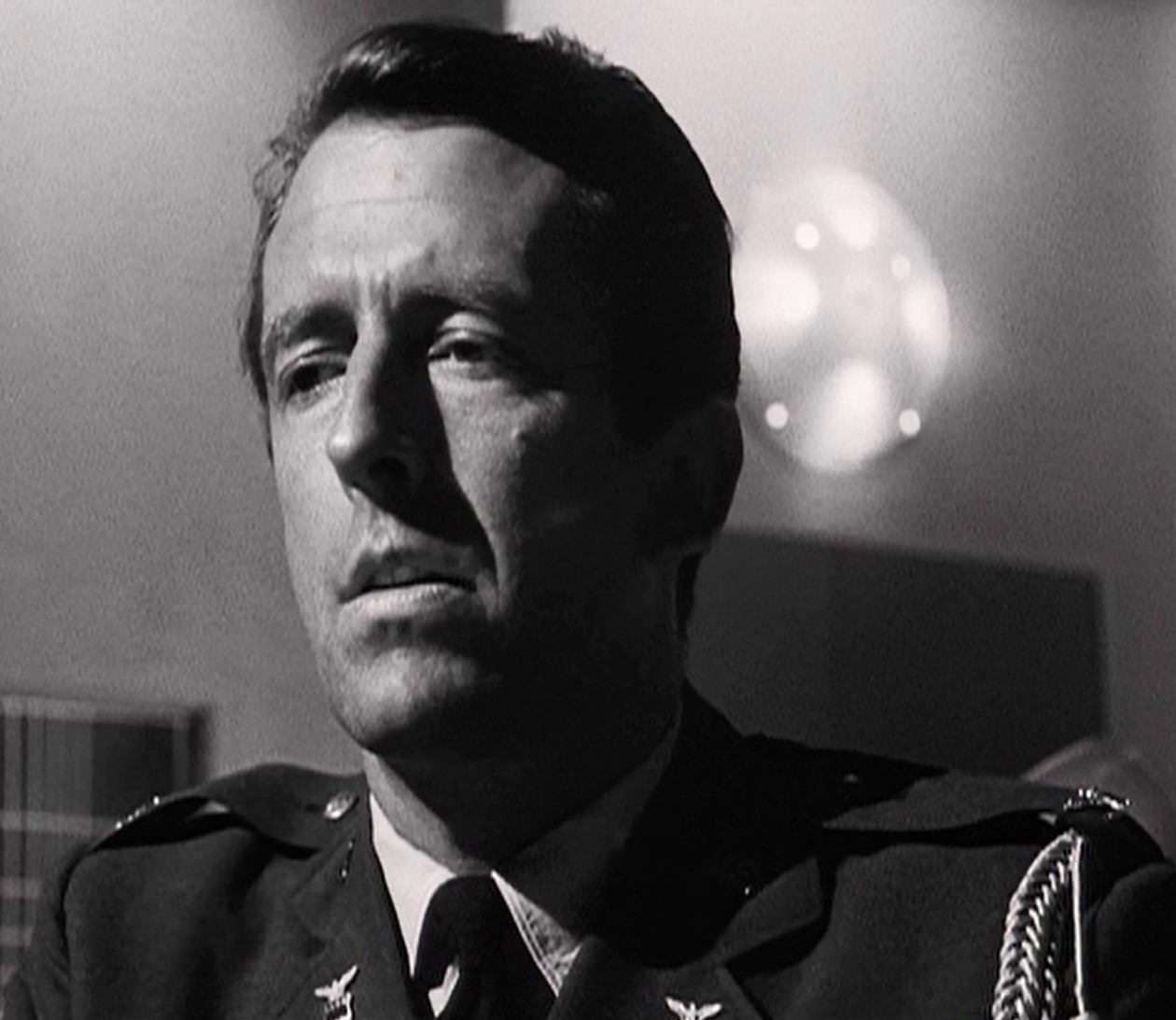
Edward Binns was "Air Force Colonel Jack Grady".

Larry Hagman was the President's interpreter "Buck".

As I said this is not "Strangelove", but a deadly serious motion picture. Truly playing on America's NIGHTMARISH FEARS of nuclear attack and possibly, at the time of this writing, the same fear of what is happening with North Korea.
America, like the Soviet Union and most Western Countries, by 1964, were using computers to tighten our defense capabilities. Nothing could possibly go wrong by removing the human stress factor.
The novel "Red Alert" and the Stanley Kubrick film relied on the pressure of the job getting to someone. "Fail Safe" went to those computers and the fact that they were more reliable than human beings, or were they?
Merriam-Webster defines the term "Fail Safe" in the context of this motion picture as:
During a scheduled visit to the Strategic Air Command's "Offutt Air Force Base, Omaha, Nebraska, a real location used in both the novel and motion picture.

The Air Forces early warning system indicates an identified aircraft has entered United States airspace. After a few minutes the "Intruder" is identified as an off course airliner and the alert is cancelled. Everything is functioning as promised, BUT
a Computer Error occurs in those infallible machines the Military depends upon. One bomber group gets a message to proceed to the Soviet Union and drop nuclear bombs on Moscow.

Attempts to contact the bomber group fails, because a new Soviet Countermeasure is jamming radio signals. With his orders apparently confirmed. "Colonel Jack Grady" orders his bomber group to precede to their target and drop their payloads.
The President of the United States gives the order to have American planes shoot the other group down. The "Hot Line" is used to contact the Soviet Premier and both the President and Premier acknowledge, for what's it worth, mistakes on both sides.
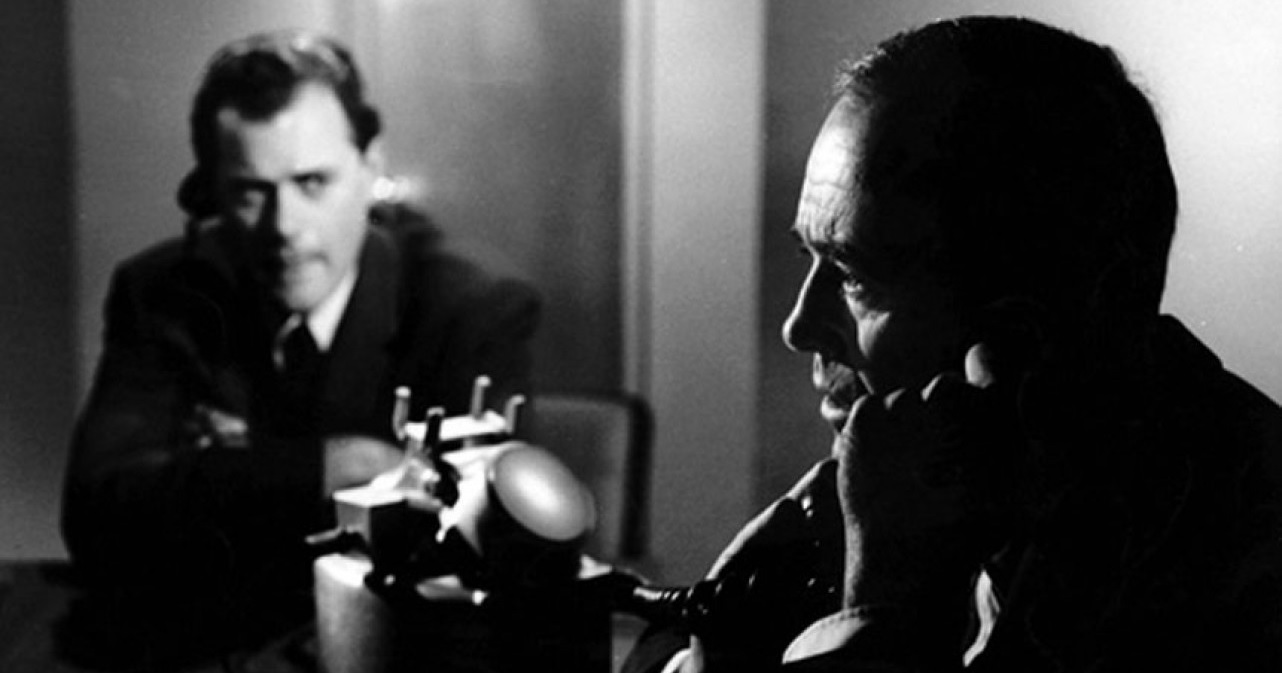
The Soviets stop the jamming, but another "Fail Safe". of sorts, kicks in. As "Grady", falling his training, refuses to believe the counter orders are not a Soviet hoax.

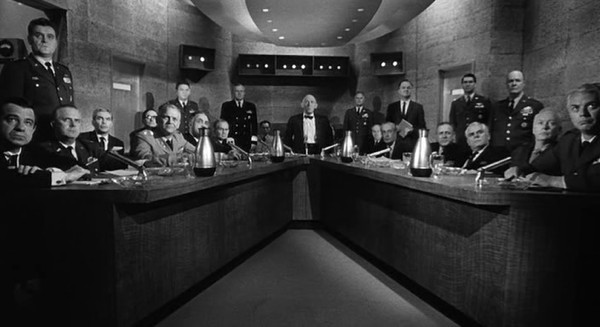
The President struggles with how to appease the Soviets, who are never seen in the picture, to avoid all out nuclear war, He offers to drop a nuclear bomb on an American City without warning. The Soviet Premier agrees and the target will be New York were the President's wife, the First Lady, is visiting. He will not warn her to leave.

A single American bomber arrives over Moscow and drops its payload. The American President orders "General Black", whose wife and children are also in New York, to send a plane to drop a nuclear bomb on the city. The Empire State building will be ground zero.
After the bomb is being dropped "General Black" commits suicide. The final moments of the feature show people in New York going about their normal daily lives and then a white to black fade out.
On April 9, 2000 actor George Clooney was Executive Producer and "Air Force Colonel Jack Grady" in a live television version of "Fail Safe". Pardon the pun, but it bombed.
Four motion pictures reflecting a period of time when the World feared, not loved, the bomb. I could have said you had to be in the United States to appreciate that time, but events in this country seem to be reviving those fears. Only with a different set of players.


Frank Overton was "United States Air Force General Bogan".

Fritz Weaver was "Air Force Colonel Cascio".

Edward Binns was "Air Force Colonel Jack Grady".

Larry Hagman was the President's interpreter "Buck".

As I said this is not "Strangelove", but a deadly serious motion picture. Truly playing on America's NIGHTMARISH FEARS of nuclear attack and possibly, at the time of this writing, the same fear of what is happening with North Korea.
America, like the Soviet Union and most Western Countries, by 1964, were using computers to tighten our defense capabilities. Nothing could possibly go wrong by removing the human stress factor.
The novel "Red Alert" and the Stanley Kubrick film relied on the pressure of the job getting to someone. "Fail Safe" went to those computers and the fact that they were more reliable than human beings, or were they?
Merriam-Webster defines the term "Fail Safe" in the context of this motion picture as:
being or relating to a safeguard that prevents continuing on a bombing mission according to a preconceived planAgain nothing to worry about.
During a scheduled visit to the Strategic Air Command's "Offutt Air Force Base, Omaha, Nebraska, a real location used in both the novel and motion picture.

The Air Forces early warning system indicates an identified aircraft has entered United States airspace. After a few minutes the "Intruder" is identified as an off course airliner and the alert is cancelled. Everything is functioning as promised, BUT
a Computer Error occurs in those infallible machines the Military depends upon. One bomber group gets a message to proceed to the Soviet Union and drop nuclear bombs on Moscow.

Attempts to contact the bomber group fails, because a new Soviet Countermeasure is jamming radio signals. With his orders apparently confirmed. "Colonel Jack Grady" orders his bomber group to precede to their target and drop their payloads.
The President of the United States gives the order to have American planes shoot the other group down. The "Hot Line" is used to contact the Soviet Premier and both the President and Premier acknowledge, for what's it worth, mistakes on both sides.

The Soviets stop the jamming, but another "Fail Safe". of sorts, kicks in. As "Grady", falling his training, refuses to believe the counter orders are not a Soviet hoax.


The President struggles with how to appease the Soviets, who are never seen in the picture, to avoid all out nuclear war, He offers to drop a nuclear bomb on an American City without warning. The Soviet Premier agrees and the target will be New York were the President's wife, the First Lady, is visiting. He will not warn her to leave.

A single American bomber arrives over Moscow and drops its payload. The American President orders "General Black", whose wife and children are also in New York, to send a plane to drop a nuclear bomb on the city. The Empire State building will be ground zero.
After the bomb is being dropped "General Black" commits suicide. The final moments of the feature show people in New York going about their normal daily lives and then a white to black fade out.
On April 9, 2000 actor George Clooney was Executive Producer and "Air Force Colonel Jack Grady" in a live television version of "Fail Safe". Pardon the pun, but it bombed.
Four motion pictures reflecting a period of time when the World feared, not loved, the bomb. I could have said you had to be in the United States to appreciate that time, but events in this country seem to be reviving those fears. Only with a different set of players.







No comments:
Post a Comment